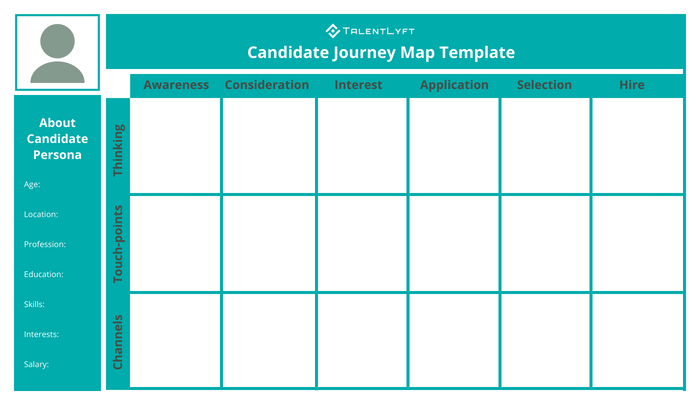

What is the Candidate Journey Map?
The Candidate Journey Map has become a trend among HR teams as Employer Branding becomes more relevant.
According to a study conducted by CareerArc, almost 60% of candidates have had a poor candidate experience. Yes, too high a number. Why? Mostly it is due to the lack of thought or empathy in the process.
In order to improve the candidate experience, specialists use the Candidate Journey Map to carry out a more detailed analysis in the company’s recruitment processes.
What is the Candidate Journey Map?
The Candidate Journey Map is an analytical activity that aims to create a visual representation (a map) of the recruitment process, from the perspective of the candidate (candidate journey).
This candidate journey is typically divided into 6 stages: Awareness, Consideration, Interest, Application, Selection, and Hiring.
However, at inlea we always suggest adding post-recruitment or on-boarding to this analysis.
¿Why is Candidate Journey Map important?
First of all, this is all about providing the experience you would like to receive. These types of analytical activities are a perfect tool for evaluating whether the recruitment process you are offering is aligned with the company’s human values. It is necessary to evaluate if the candidates are having a respectful and transparent experience, for example.
Also do not forget that on many occasions the candidates can also be your current or potential clients.
Secondly, improving selection processes will also help significantly improve the company’s image and reputation. As a result, you will be able to attract better qualified talent and reduce turnover rates and costs.
This strategy is known as Employer Branding. If you still do not know about it, we suggest you reading our article “What is Employer Branding?“.
What are the phases of the journey to take into consideration?
The stages of the candidate journey can be summarized in three phases: the pre-recruitment, the selection process, and the post-recruitment.
-
The Pre-recruitment
Pre-recruitment consists of the awareness, consideration, and interest stages.
In this phase, the potential candidate has the first contact with the company. This is the moment when they start getting to know you, to know what you do, how the company is organized, in which regions it operates, what benefits are offered to employees, what the values are, etc.
It is a phase highly influenced by the reputation of the company and by communication on social networks such as LinkedIn.
-
The selection process
The selection process consists of the application, selection and hiring stages.
From here you will have much more control of how candidates perceive your company.
Both in the application stage and in the selection stage, you will have to work on how you address to the candidate. The candidate’s experience will change a lot depending on the degree of communication you have with him or her.
For example, during the application stage, a personalized email can be programmed to thank the interested party for submitting the application. It is a plus if you indicate an estimated time period for providing an assessment.
In the selection and hiring stages, the most important factors for candidates are consideration and transparency. For example, punctuality is very important, indicate how many interviews you plan to carry out and with whom or how long the selection process can last.
This phase is an excellent opportunity to show candidates why they should work for your company.
On the other hand, at inlea we always recommend having constant communication with the candidate and once the decision is made, providing feedback. This feedback can be of great help to the candidate. Remember that not reporting the decision made or doing it without giving feedback is a very poor practice.
-
The Post-recruitment
This is one of the most overlooked phases in the recruitment process, when in fact is of great importance.
Post-recruitment is formed by the onboarding stage. In this stage, the candidate lands in the company and, usually in a short time, has to digest all the processes and information.
Poor onboarding can significantly affect employee performance and, in the worst case, cause the employee to fail the probationary period.
At inlea we recommend preparing a personalized onboarding for the specific job that the employee will carry out. Plus, assigning a person from HR and another from the candidate’s new team to accompany him in the first weeks and make sure that is well incorporated.

¿How to elaborate a Candidate Journey Map?
The following steps are used to create the visual representation of the candidate’s journey:
-
Define what type of candidate you are looking for
The first step is to create a fictional character that meets the characteristics of the ideal candidate you are looking for.
This will help you understand their way of thinking and what they expect from a recruitment process.
-
Identify what the candidate expects to experience in each phase
This step, in short, is about putting yourself at the candidate’s feet and for each phase mentioned above, defining what our ideal candidate would expect from us.
Another very effective exercise is to put yourself as the candidate.
We recommend you doing this exercise in a very visual way with a table and answering the following questions (from the candidate perspective):
-
-
- Through what channels do I seek employment?
- What kind of brands am I attracted to?
- What benefits do I want to receive as employee?
- How can I find out what it is like to work at this company?
- What differentiates the company I am looking for from others?
- What type of application do I want or am I willing to submit?
- Do I expect you to thank me for filling out a form? And for having sent a CV and a letter of recommendation?
- How many interviews am I willing to do? With how many people?
- How long do I expect the selection process to take?
- What kind of information about the company would I like to receive in the first interviews?
- At what point in the selection process do I want to know the salary?
- Do I expect you to provide me with feedback? When?
- What information do I expect to receive once I have been selected?
- Do I want to have a mentor or guide? How many?
- What do I expect to find on the first day of work?
- With which departments of the company do I want to meet to know in detail?
- What first interactions do I want to have with my new co-workers?
-
-
-
Analyze, plan and act
Once you answer the previous questions and analyze each stage of the recruitment process, you will be able to tell what needs to be improved. This analysis must be followed by planning and actions in order to achieve positive results.
We recommend you establishing some KPIs to be able to measure that the strategy has been successful. For example, once the recruitment process is finished, you could carry out an anonymous survey to find out how satisfied the candidates are.
In general, the Candidate Journey Map is a perfect tool to question your recruitment process.
A detailed recruitment process can have a significant impact on the company’s reputation. If you want to know more about Employer Branding, do not hesitate to contact our experts.


